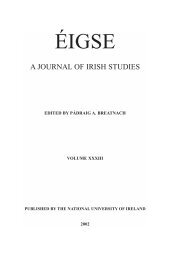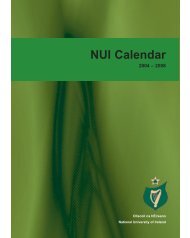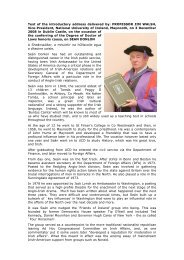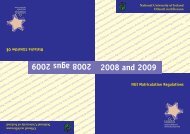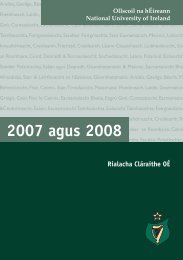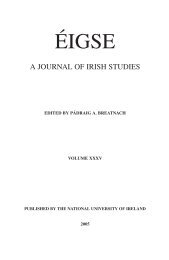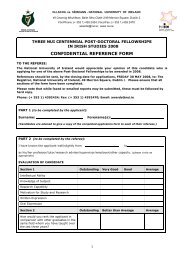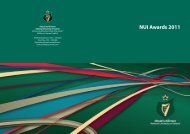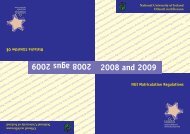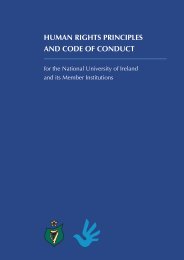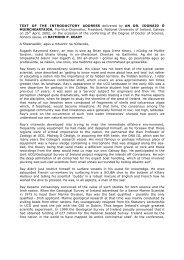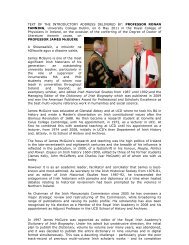Eigse Paged 2004 - National University of Ireland
Eigse Paged 2004 - National University of Ireland
Eigse Paged 2004 - National University of Ireland
Create successful ePaper yourself
Turn your PDF publications into a flip-book with our unique Google optimized e-Paper software.
SETTLEMENT IN MEDIEVAL IRELAND 27<br />
attempted, unsuccessfully in my opinion, to push the emergence <strong>of</strong><br />
the element back as far as the ninth or tenth century. 8<br />
Baile is extremely rare in placenames before the twelfth century.<br />
The earliest datable examples I have found come from the eleventhcentury<br />
version <strong>of</strong> Táin Bó Cúailnge in Lebor na hUidre. 9 One <strong>of</strong> the<br />
itineraries written in hand M in that manuscript mentions a place<br />
called Baile, and in later manuscripts <strong>of</strong> the same version we find a<br />
Baile and a Baile in Bili. 10 Baile in Bili occurs in a poem which, as it<br />
stands, is hardly any older than the eleventh century. There is no context<br />
to determine a meaning for baile here, but a translation ‘place <strong>of</strong><br />
the great tree’ is certainly plausible. The two occurrences <strong>of</strong> Baile<br />
probably refer to a single place. 11 This is a peculiar name regardless<br />
<strong>of</strong> whether we take it as meaning ‘place’ or some kind <strong>of</strong> settlement:<br />
there is no qualifier as is invariably the case with baile-names, and it<br />
lacks the definite article. 12 This irregularity and doubt as to its meaning<br />
must exclude it from further consideration in the present discussion.<br />
A number <strong>of</strong> eleventh- or early twelfth-century texts contain references<br />
to baile-settlements. For example, the Irish Life <strong>of</strong> St<br />
Patrick, Bethu Pátraic, which may have been compiled as late as c.<br />
1100 A.D. from earlier materials, recounts that a certain Victor<br />
slipped out <strong>of</strong> Domnach Maigen (Donaghmoyne) and concealed<br />
himself in a thorn bush beside the baile (hitaeb inbaili) so as to avoid<br />
an encounter with St Patrick. 13 Baile here is apparently used with<br />
specific reference to a settlement, but no details are included. In all<br />
8<br />
Flanagan, ‘Common elements: baile’ 9.<br />
9<br />
But note also the name Tráig Baile the second element <strong>of</strong> which, however, is<br />
traditionally explained as the personal name Baile mac Buain (The Book <strong>of</strong> Leinster<br />
formerly Lebar na Núachongbála, ed. R. I. Best, Osborn Bergin, and M. A. O’Brien,<br />
6 vols (Dublin 1954-83), ll 4029, 34610). The name is attested in the Annals <strong>of</strong> the<br />
Four Masters under the year 1104 (Annála Ríoghachta Éireann: annals <strong>of</strong> the kingdom<br />
<strong>of</strong> <strong>Ireland</strong> by the Four Masters [AFM], ed. John O’Donovan, 7 vols (Dublin<br />
1848–51) II 978).<br />
10<br />
Baile (Táin Bó Cúailnge Recension I, ed. Cecile O’Rahilly (Dublin 1976)<br />
l. 127), in búadach Baili (ibid. l. 3790), Baili in Bili (ibid. l. 2923).<br />
11<br />
ibid. p. 307.<br />
12<br />
See Gregory Toner, ‘The definite article in Irish place-names’ Nomina 22 (1999)<br />
5-24.<br />
13<br />
tanic Uictor do imgabáil Pátraic asin port co rraboi i mmuiniu draigin boí i tóeb<br />
in baili (Bethu Phátraic: the Tripartite Life <strong>of</strong> Patrick, ed. Kathleen Mulchrone<br />
(Dublin 1939) 111 (= Whitley Stokes, The Tripartite Life <strong>of</strong> Patrick 2 vols (London<br />
1887) I 182. 10-12 where baile is translated ‘stead’). On the dating <strong>of</strong> the text see<br />
David Dumville et al., Saint Patrick A.D. 493-1993 (Woodbridge 1993) 255-8.



